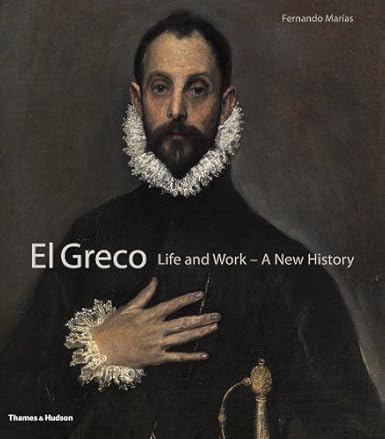 |
| Picture:Amazon |
Fernando Marías El Greco Life and Work: A new history Thames & Hudson 2013, £60
El Greco's life is fascinating. He was born in Crete, moved to Venice where he may have trained with Tintoretto, then to Rome where he stayed at the Farnese court, before moving to Spain and spending most of his career in Toledo. He was a prickly and outspoken character who dismissed Michelangelo, was expelled from the Farnese household and was often in dispute with patrons. He never joined one of the confraternities that were at the centre of social life in Toledo and seems always to have been regarded as an outsider. This splendid new biography vividly evokes the cities where El Greco lived and establishes the influences that shaped El Greco's great and unique oeuvre.
Marías opens by rebutting the myths that have formed around this enigmatic artist and introducing us to the surprising range of primary sources, including El Greco's annotated copy of Vasari's Lives of the Artists. He is attuned to "the precarious nature of any attempt at writing a biography or reconstructing the journey of someone's life, which may leave behind little more than a body of work and a reputation, which is not straightforward nor everlasting, but subject to the vicissitudes of elusive and fickle fortune" (p. 283).
El Greco was successful in obtaining commissions for vast altarpieces, and he often obtained high prices. Marías focuses on the altarpieces, because they are the highpoints of his art and because they are more often documented. El Greco and his studio also produced many small devotional pictures, including many of saints and apostles. We know little about the circumstances of their creation or of their purchasers and they are discussed only briefly, but it's interesting to speculate about how critical opinion regarded these pictures that were so different from anything else produced in Spain at that time. Today El Greco is generally regarded as a Spanish artist, especially by the Spanish, but I've always thought him closer to the Venetians. London's National Gallery wisely hangs him with the Venetian school.
El Greco moved to Toledo after failing to get a position at the court in Madrid. The Martyrdom of St Maurice was commissioned later for El Escorial (where it remains). It's an unusual interpretation, showing the future martyrs conversing in the foreground, with the scenes of their martyrdom relegated to the background. Its artistry was esteemed, but it was considered unsuitable for the altar for which it was painted and relegated to a sacristy or corridor. Fray José de Sigüenza quotes El Mudo as saying that "saints should be painted in such a way that our desire to pray to them is not destroyed; rather, they should inspire devotion, since this ought to be the principal effect and aim of painting" (p. 146). Notwithstanding fogies like El Mudo, El Greco continued to get commissions for great altarpieces, although the vicissitudes of fortune caused him to suffer periods of greatly reduced income.
The production of this book falls short of the text. The captions don't give dimensions, which is particularly important with El Greco because he painted the same images as vast altarpieces and as tiny modelli and ricordi (the book illustrates the diminutive El Espolio at Upton House and the full-size altarpiece in Toledo, but you wouldn't know relative sizes from these illustrations). Some of the references send you to the wrong pages and the images in the copy I read were not of the highest quality. El Greco's early Flight into Egypt from the Hirsch collection is listed as in a private collection in London, but it was acquired by the Prado several years ago. Splitting the face across a double-page spread in a detail photograph of the great portrait of Fray Hortensio Félix Paravicino from Boston is particularly unfortunate (pp. 244-245); it means you appreciate the detail of the background and lose the face in the fold.
This is still the best book published on El Greco for very many years. It's primarily a biography, but the discussion of the pictures themselves is excellent and I do hope Marías follows up with a new catalogue raisonné to replace Harold Wethey's, which was published back in 1962.
I'm afraid the new catalog raisonné will not be done by Marias. The first part was conducted by Alvarez Lopera and included mostly early works and altarpieces. After his death (five years ago), the person responsible for continuing the work is Leticia Ruiz, curator of Spanish painting until the sixteenth century, in the Museum of the Prado. Work is scheduled to finish in 2016.
ReplyDeleteThe error on the Flight into Egypt because the book was first edited in 1997, and at that time the Prado not possessed the painting yet, but this is no excuse, merely the publisher has saved money in the review.
Thanks Roberto. Glad that the catalogue is being written!
Delete